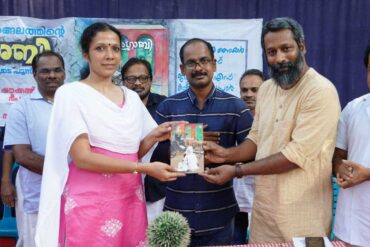The state of Kerala proudly flaunts the tagline—God’s own Country—conferred on her, besides other reasons, for her enviable track record on the health front. Kerala’s health indices are comparable to, or even better those of developed nations, including the Scandinavian nations—considered the healthiest in the world.
But, frequent fever epidemics have been chipping away at Kerala’s reputation as “the healthiest Indian state.” These epidemics inflict severe physical and financial strain on the citizens and the government.
According to official data, a total of 20,46,455 viral fever cases were reported in Kerala in 2014, 19,25,690 cases in 2015, 15,41,441 cases in 2016-17, and 21,49,204 in 2017-18. And 14.6 lakh people were afflicted with various communicable diseases in the first half of 2017. Fevers like Dengue, Malaria, Leptospirosis (rat fever), Hepatitis (A and B), and diarrheal diseases including Cholera, Chicken pox, and H1N1 had claimed 114 lives during that period.
Kerala’s population is 3.3 crore, which means one in every 23 residents was affected by one communicable disease or another!
The first half of 2018 saw a lull on the fever front. That was when Perambra, near Kozhikode, became the focal point of Nipah outbreak causing the death of 17 people. This strange contagious virus was previously unknown in Kerala and led to hundreds of people with fever rushing to hospitals in panic.
Meanwhile, the Pune-based National Institute of Virology (NIV) confirmed four deaths from the same family as those caused by the Nipah virus. The deadly virus also caused the death of a nurse who attended to a patient that succumbed to the disease. This had the health care personnel in Kerala in a state of extreme panic as expected. This new villain, that had Kerala shiver, both out of fear and uncertainty about the disease, and its manifestations, was an absolute stranger to the medical fraternity in this part of the world.
At present, a 28-year old engineering student hailing from Ernakulam district, who was being treated for fever, has been confirmed as a case of Nipah, sending the state and the government into ‘battle mode’ exactly one year after the Kozhikode epidemic.
What is Nipah Virus?
Nipah Virus (NiV) infection is a newly emerging Zoonosis (an animal disease that can be transmitted to humans) that causes severe disease manifestations in animals and humans. The natural host of the virus is Fruit Bats belonging to the Pteropodidae family, Pteropus genus. NiV was first identified during an outbreak of the disease in Kampung Sungai Nipah, Malaysia in 1998 (hence its name). On that occasion, pigs were the intermediate hosts. About 100 perished then.
India witnessed two outbreaks among humans in 2001 and 2007 in West Bengal. Bangladesh was hit by an epidemic of NiV infection in 2004. At that time, humans were infected with NiV through consumption of date palm sap that had been contaminated by infected fruit bats. Human-to-human transmission has now been reported through the cases reported in Kozhikode, and during an outbreak in Siliguri, where 33 health workers and hospital visitors took ill after exposure to patients hospitalized with NiV infection.
These therefore exemplify modes of transmission of NiV:
- Human-to-human, as in Siliguri and Kozhikode: Here people coming into contact with persons already harboring the virus or, with body fluids of those infected contract the infection. People who attended the funeral of those who perished in Kozhikode too were infected. They must have come in close contact with the bodies.
- Fruit bat-to-humans: By coming in contact with infected bats, or by consuming fruits and toddy being collected in pots atop palms, which might have been consumed by infected bats, or infected with excreta or body fluids from infected bats.
- From an intermediate host like pig: Pigs eat fruits partially consumed by infected bats. Humans later consume meat of infected pigs or come in close contact with them in pigsties, as in Nipah in Malaysia. Horse is believed to be another intermediate host, as observed in NiV outbreaks in Australia.
The virus has an incubation period (time interval between the instance a person is actually infected by the virus and appearance of symptoms) of 6-14 days. For people with good immunity, this could extend up to 21 days. As per established protocol, a person should be monitored for double the incubation period before declaring him/her ‘virus-free’, which implies that will have to wait for 42 days, before being declared cleared.
What are the manifestations of NiV infection?
NiV infection can manifest with mild symptoms like fever, severe headache, body ache, weakness and cold as an ordinary flu, or develop altered mental status and seizures, indicating inflammation of the brain (encephalitis). Some develop severe breathlessness, cough and drop in oxygen levels in the blood suggesting Acute Respiratory Distress Syndrome (ARDS) requiring ventilator therapy in an Intensive Care Unit (ICU). The latter two are the ones that kill. The case fatality rate is 40-75%, and may even be 100%.
How is it diagnosed?
Diagnosis is made by establishing presence of the virus in the blood and body fluids through tests available in National Institute of Virology in Pune.
How is it treated?
Treatment of NiV infection is supportive in an ICU. Cases of ARDS will require ventilator support. There is no single medication available to cure the illness. Recently, an antiviral drug called Ribavarine is reported to be of use in treating NiV infection. There is no vaccine available against the deadly infection, stressing that the only sensible option is to religiously observe preventive measures to stave off infection, lest Kerala shiver again due to fever caused by NiV
What are the preventive measures?
- Prevent contact with bat excreta and consumption of fruits half eaten or bitten by fruit bats.
- Maintain a minimum distance of one meter (one arm’s length) when visiting patients or people suspected to be infected.
- Use personal masks and gloves when visiting patients in hospitals (as far as possible, try to avoid direct physical contact with them)
- Use soap and water to wash before and after meals, or after visiting patients.
- Use gloves and personal protection while handling excreta of domestic animals
- Avoid consuming toddy collected in open containers atop palms in areas with large bat population.
- Avoid close contact with domestic animals.
- Avoid sharing utensils, clothes and bed linen used by persons suspected to be, or confirmed to be infected with NiV.
- Avoid close contact with mortal remains of those who died of NiV infection.
- Avoid touching the body with bare hands during funeral ceremonies.
For health care givers and institutions:
- Use Personal Protective Equipment (PPE) and masks while interacting with patients.
- Sterilize non-disposable equipment.
- Use of PPEs by nurses and other caregivers while taking care of patients
- Carefully handle equipment while drawing body fluids for tests
- Enforce strict isolation and, admit confirmed patients away from other patients, especially immune-compromised ones.
- Avoid careless disposal of surgical instruments after use
- Avoid crowding of ICUs and other treatment facilities within hospitals.
- Encourage use of disposable items in hospitals for suspected and confirmed cases of NiV.
- Avoid careless discarding of used gloves and gowns.
- Observe proper care while handling patients who succumbed to NiV. Extreme care must be observed while handling body fluids before the funeral.
If these measures are religiously adhered to, this seemingly deadly disease can be contained to a large extent, and deny it a chance to have Kerala shiver through it.







